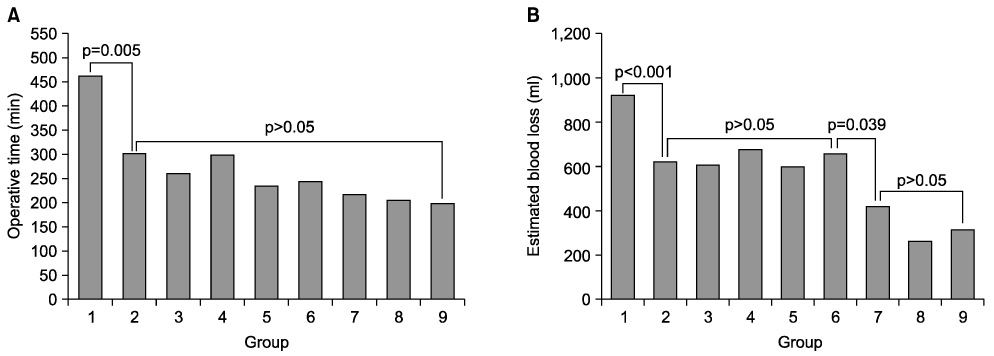Korean J Urol.
2009 Nov;50(11):1095-1100.
Laparoscopic Radical Prostatectomy: Learning Curves for Surgical, Oncological, and Functional Outcome
- Affiliations
-
- 1Department of Urology, Seoul National University College of Medicine, Seoul, Korea. hhkim@snu.ac.kr
Abstract
- PURPOSE
We report our experience with laparoscopic radical prostatectomy (LRP) and investigate the learning curves for various outcome variables for LRP.
MATERIALS AND METHODS
From January 2005 to March 2008, 47 patients with prostate cancer with a clinical stage < or =T3a underwent LRP by a single surgeon. We retrospectively reviewed the medical records of the patients regarding to the surgical, oncological, and functional outcomes.
RESULTS
The median follow-up for the entire group was 38 months (18-49). In surgical outcomes, the operative time was decreased to less than 300 minutes after 5 cases and the estimated blood loss was stabilized after 30 cases. The positive surgical margin rate was decreased within the first 30 cases, but not significantly so. For functional outcomes, the urinary continence rates at 1 month, 3 months, 6 months, and 1 year postoperatively were 17.0%, 53.2%, 72.3%, and 80.9%, respectively. Neurovascular bundle saving was performed in 11 cases (23.4%). In cases of neurovascular bundle saving, the potency rates at 3 months, 6 months, and 1 year postoperatively were 27.3%, 27.3%, and 54.5%, respectively. Analysis of the learning curve for functional outcome revealed no statistical differences in the continence rate or potency rate with time.
CONCLUSIONS
In the present study, the learning curve for operative time was overcome within the first 5 cases, and estimated blood loss took 30 cases to reach a plateau. The longest learning curve was for functional outcomes such as continence and potency, which did not stabilize until 47 cases.
Keyword
MeSH Terms
Figure
Reference
-
1. Clayman RV, Kavoussi LR, Figenshau RS, Chandhoke PS, Albala DM. Laparoscopic nephroureterectomy: initial clinical case report. J Laparoendosc Surg. 1991. 1:343–349.2. Schuessler WW, Schulam PG, Clayman RV, Kavoussi LR. Laparoscopic radical prostatectomy: initial short-term experience. Urology. 1997. 50:854–857.3. Stolzenburg JU, Rabenalt R, Do M, Kallidonis P, Liatsikos EN. Endoscopic extraperitoneal radical prostatectomy: the University of Leipzig experience of 2000 cases. J Endourol. 2008. 22:2319–2325.4. Salomon L, Levrel O, de la Taille A, Anastasiadis AG, Saint F, Zaki S, et al. Radical prostatectomy by the retropubic, perineal and laparoscopic approach: 12 years of experience in one center. Eur Urol. 2002. 42:104–110.5. Bhayani SB, Pavlovich CP, Hsu TS, Sullivan W, Su LM. Prospective comparison of short-term convalescence: laparoscopic radical prostatectomy versus open radical retropubic prostatectomy. Urology. 2003. 61:612–616.6. Dahl DM, He W, Lazarus R, McDougal WS, Wu CL. Pathologic outcome of laparoscopic and open radical prostatectomy. Urology. 2006. 68:1253–1256.7. Eden CG, Neill MG, Louie-Johnsun MW. The first 1,000 cases of laparoscopic radical prostatectomy in the UK: evidence of multiple 'learning curves'. BJU Int. 2009. 103:1224–1230.8. Bollens R, Sandhu S, Roumeguere T, Quackels T, Schulman C. Laparoscopic radical prostatectomy: the learning curve. Curr Opin Urol. 2005. 15:79–82.9. Trabulsi EJ, Hassen WA, Touijer AK, Saranchuk JW, Guillonneau B. Laparoscopic radical prostatectomy: a review of techniques and results worldwide. Minerva Urol Nefrol. 2003. 55:239–250.10. Walsh PC, Marschke P, Ricker D, Burnett AL. Patient-reported urinary continence and sexual function after anatomic radical prostatectomy. Urology. 2000. 55:58–61.11. Guillonneau B, Vallancien G. Laparoscopic radical prostatectomy: the Montsouris technique. J Urol. 2000. 163:1643–1649.12. Kim SW, Hong SH, Hwang TK. Laparoscopic radical prostatectomy: the learning curve of the initial 150 cases. Korean J Urol. 2008. 49:879–885.13. Kang MY, Ku JH, Kwak C, Kim HH. The learning curve analysis of laparoscopic radical prostatectomy: comparison with retropubic radical prostatectomy. Korean J Urol. 2008. 49:18–23.14. Veltri RW, Isharwal S, Miller MC, Epstein JI, Mangold LA, Humphreys E, et al. Long-term assessment of prostate cancer progression free survival: evaluation of pathological parameters, nuclear shape and molecular biomarkers of pathogenesis. Prostate. 2008. 68:1806–1815.15. Vickers AJ, Savage CJ, Hruza M, Tuerk I, Koenig P, Matinez-Pineiro L, et al. The surgical learning curve for laparoscopic radical prostatectomy: a retrospective cohort study. Lancet Oncol. 2009. 10:475–480.
- Full Text Links
- Actions
-
Cited
- CITED
-
- Close
- Share
- Similar articles
-
- Robot-Assisted Laparoscopic Radical Prostatectomy
- Laparoscopic Radical Prostatectomy: the Learning Curve of the Initial 150 Cases
- Learning Curve of Robot-Assisted Laparoscopic Radical Prostatectomy for a Single Experienced Surgeon: Comparison with Simultaneous Laparoscopic Radical Prostatectomy
- Extraperitoneal Laparoscopic Radical Prostatectomy: Clinical Experience and Learning Curve with 103 Cases
- The Learning Curve Analysis of Laparoscopic Radical Prostatectomy: Comparison with Retropubic Radical Prostatectomy



